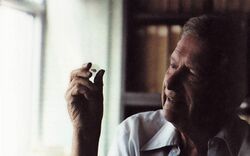Biography:Brian Mason (geochemist)
Brian Mason | |
|---|---|
 Mason showing a slice of a Moon meteorite, May 1994 | |
| Born | Brian Harold Mason 18 April 1917 Port Chalmers, New Zealand |
| Died | 3 December 2009 (aged 92) Washington, D.C., U.S. |
| Alma mater | University of Stockholm |
| Known for | Meteorite classification |
| Awards |
|
| Scientific career | |
| Fields | |
| Institutions |
|
| Thesis | Mineralogical aspects of the system FeO - Fe2O3 - MnO - Mn2O3 (1943) |
| Doctoral advisor | Victor Moritz Goldschmidt |
| Doctoral students | Ross Taylor[1] |
Brian Harold Mason (18 April 1917 – 3 December 2009) was a New Zealand geochemist and mineralogist who was one of the pioneers in the study of meteorites.[2] He played a leading part in understanding the nature of the Solar System through his studies of meteorites and lunar rocks. He also examined and classified thousands of meteorites collected from Antarctica.[3][4]
Life
Mason was born in Port Chalmers, Dunedin, in 1917 and was brought up in Christchurch. He was educated at Christchurch Boys' High School and studied geology and chemistry at Canterbury University College, graduating MSc with first-class honours in 1939.[5] In November, he left for Norway to work towards a doctorate, arriving in January 1940, but along with a colleague who held a British passport fled to Sweden in May following Operation Weserübung, the German invasion of Norway. In 1943, he completed a PhD in geochemistry at the University of Stockholm under Victor Goldschmidt[citation needed] and left the country for Britain.[6]
Mason returned to Christchurch where he was appointed lecturer in geology at Canterbury University College. He taught there for two years. In 1947, he was appointed professor of mineralogy at Indiana University where he was based for rest of his life. He was a curator of mineralogy at both the American Museum of Natural History, New York, and the Smithsonian Institution, Washington, D.C.
Mason died in Washington, D.C., on 3 December 2009[7] from renal failure. He was survived by his stepson, Frank W. Turner, who lived with Mason in Chevy Chase, MD.
His third wife, Margarita C. Babb, and mother of Frank Turner, died on 3 February 2009 due to complications from multiple myeloma. They were married for 15 years. Mason was married two other times, first to Anne Marie Linn and then to Virginia Powell; both marriages ended in divorce. He had a son, George, with his second wife. George died in a mountain climbing accident in 1981 at the age of 20.
Awards and honours
- Mason won the Leonard Medal from the Meteoritical Society in 1972 and the Roebling Medal from the Mineralogical Society of America in 1993.[8][9]
- He was appointed an Honorary Fellow of the Royal Society of New Zealand in 1984.[10]
- Two minerals, brianite and stenhuggarite, have been named after Mason. Brianite is a phosphate mineral (Na2CaMg(PO4)2) and stenhuggarite (Swedish: stenhuggare, meaning "mason") is a rare iron-antimony mineral.
- Asteroid 12926 Brianmason, discovered by Christine J. Schiff in 1999, is named in his honour.[11] The official naming citation was published by the Minor Planet Center on 13 October 2000 (M.P.C. 41386).[12]
Selected works
- The literature of geology, American Museum of Natural History, 1953
- Meteorites, Wiley, 1962
- The lunar rocks, Authors Brian Harold Mason, William G. Melson, Wiley-Interscience, 1970, ISBN:978-0-471-57530-6
- Handbook of elemental abundances in meteorites, Editor Brian Harold Mason, Gordon and Breach, 1971
- Principles of Geochemistry Editor Carleton B. Moore, Wiley, 1982, ISBN:978-0-471-57522-1
- Victor Moritz Goldschmidt: father of modern geochemistry, Geochemical Society, 1992, ISBN:978-0-941809-03-0
See also
References
- ↑ "Stuart Ross Taylor (1925–2021)". Meteoritical Society. 24 May 2021. https://meteoritical.org/news/stuart-ross-taylor-1925-2021.
- ↑ Meteorites - Brian Mason, geochemist and meteorite scientist - Te Ara Encyclopedia of New Zealand
- ↑ "Brian Mason - a brief profile" , Brian Mason Scientific & Technical Trust
- ↑ "Brian H. Mason, 92: Smithsonian expert on rocks from moon", Washington Post, Patricia Sullivan, 9 December 2009
- ↑ "NZ university graduates 1870–1961: Ma". http://shadowsoftime.co.nz/university15.html. Retrieved 9 November 2014.
- ↑ Sarjeant, William (2002). "Review". Earth Sciences History 21 (2): 207–209.
- ↑ "Brian Mason". Royal Society of New Zealand. 2012. http://www.royalsociety.org.nz/organisation/academy/fellowship/obituaries/brian-mason/. Retrieved 9 November 2014.
- ↑ Taylor, Stuart Ross (1994). "Presentation of the Roebling Medal of the Mineralogical Societyof America for 1993 to Brian Mason". American Mineralogist 79: 768–769. http://www.minsocam.org/ammin/AM79/AM79_768.pdf. Retrieved 29 September 2017.
- ↑ Mason, Brian (1994). "Acceptanceof the RoeblingMedal of the Mineralogical Societyof America for 1993". American Mineralogist 79: 770–771. http://www.minsocam.org/ammin/AM79/AM79_770.pdf. Retrieved 29 September 2017.
- ↑ "List of Honorary Fellows: M–O". Royal Society of New Zealand. http://www.royalsociety.org.nz/organisation/academy/fellowship/list-of-honorary-fellows-1870-present/m-o/. Retrieved 9 November 2014.
- ↑ "12926 Brianmason (1999 SO9)". Minor Planet Center. https://www.minorplanetcenter.net/db_search/show_object?object_id=12926. Retrieved 26 February 2019.
- ↑ "MPC/MPO/MPS Archive". Minor Planet Center. https://www.minorplanetcenter.net/iau/ECS/MPCArchive/MPCArchive_TBL.html. Retrieved 26 February 2019.
External links
- Photo of and interview with Mason as part of a longer piece about the Moon rocks, in Dutch, in Vrij Nederland, July 1994
 |

